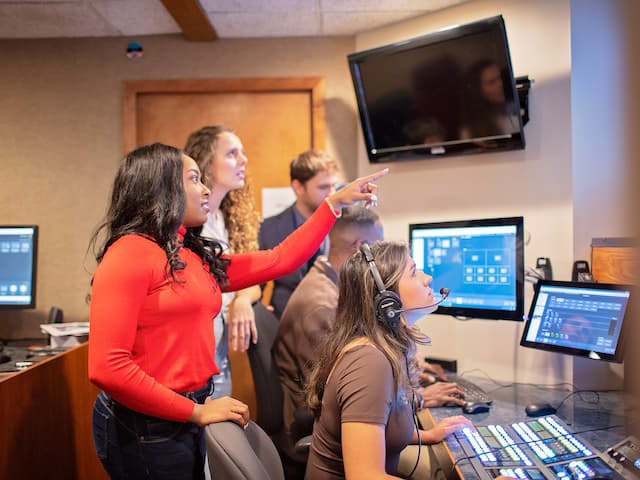
Communication and Media (CAM) students at Samford University’s Howard College of Arts and Sciences are being recognized for their undergraduate research at an international conference this spring.
17 students from the Fall 2023 JMC 401 Senior Thesis class were accepted to present their research projects at the Broadcast Education Association (BEA) convention in April, the premier international academic media organization for the advancement of educators, students and professionals in broadcast and emerging media.
This alone is an impressive feat, as the paper acceptance rate this year was around 40% across all divisions, and there is no student category for research at the conference.
However, 16 of those students took home an additional honor - receiving either first or second-place debut paper awards from various divisions. Those awarded students include journalism and mass communications and communication studies majors: Anna Baldwin, Madi Borton, Alex Brown, Cayman Carpenter, Emma Cobb, Ella Gammill, Hannah Noelle Gusko, Madison Hackett, Gracie Hoyt, Noelle Neader, Courtney Robeson, Chris Todd, Claire Trammell, Veronica Weathers, AnnaHaisten Williams and Joshua Williams.
“For undergraduate students to even be accepted at an international professional conference like this is unusual, but for them to sweep many of the top awards from the conference speaks to the high caliber of research and dedication these students had to these projects,” said Danielle Deavours, assistant professor of communication and media and the students' faculty research mentor.
The students developed their own research ideas, applied for and received Institutional Review Board approval, conducted the research, analyzed the findings and wrote a full scholarly publication in their Senior Thesis course in a single semester.
In total, the CAM students won four first-place debut papers in the News (the largest division at BEA), Research, Multicultural Studies, and Production Aesthetics and Criticism divisions, as well as two second-place debut papers in the Interactive Media and Emerging Technology and Marketing and Programming divisions. Anyone who has not submitted to the division before can submit a debut paper, meaning the undergraduate students competed against faculty and graduate student papers for these awards.
“One of our students won first place against a researcher and faculty member whose published work we used as an example of scholarly work in our classroom,” Deavours said. “The fact that they were able to compete against such high-level researchers as undergraduate students is truly impressive.”
BEA Executive Director Heather Birks said this recognition is especially notable given the conference's record-setting number of research submissions.
“This year, we received more papers and research-in-progress combined, so this was an impressive showing by one school,” she said. “It says so much about the interest in research and future scholarly work.”
The students’ research topics varied from how journalists follow up when charged criminal suspects are found not guilty; the impact the #GirlDinner trend has on disordered eating communities; the parasocial relationship transfer between Taylor Swift fans and her dating partners; the frames used to portray serial killers, victims and law enforcement in true crime dramatizations; the symbolic annihilation of indigenous populations and their land use in the film “Oppenheimer”; the history of voiceover from “Steamboat Willie” to today; and the role of social media in creating fan relationships for new artists.
“One of my favorite things about this class is that it takes students who are so intimidated by the thought of research, and it shows them how they can explore a topic they care about using high-level, professional research skills,” Deavours said. “I love seeing the passion that develops as they get deeper into the topic. I knew these students’ work was special when I was mentoring them, but to see so many of them recognized at such a high level is truly amazing. I’m very proud of them.”
Deavours, the student’s faculty research mentor, also won a first-place award in the open category of the Research division this year for her work on nonverbal neutrality norms of broadcast journalists.
Deavours and the students will present their work at the international Broadcast Education Association conference this April in Las Vegas, NV.
- News division, Debut 1st Place Paper: Hannah Noelle Gusko, Samford University; Crime Reporting in Mass Media: Examining the Follow-Up Process on the Wrongfully Accused (solo-authored)
- IMET division, Debut 2nd Place Paper: Cayman Carpenter, Emma Cobb, Ella Gammill, Noelle Neader, & Veronica Weathers, Samford University; Girl Dinner Textual Analysis of Trend Degradation Towards Disordered Eating (group)
- Research Division, Debut 1st Place Paper: Anna Baldwin, Gracie Hoyt, & Madi Borton, Samford University; Have I Know You 20 Seconds or 20 Years? A Study on the Parasocial Relationships Between Taylor Swift and Her Fans (group)
- Multicultural Studies Division, Debut 1st Place Paper: Madison Hackett, Samford University: Erasing the Footprints, Glorifying the Bomb: How the Oppenheimer Movie Overlooks Indigenous Experiences at Nuclear Test Sites (solo)
- Production Aesthetics and Criticism Division, Debut 1st Place Paper: Courtney Robeson, Claire Trammell, & Alex Brown, Samford University: The Most Dangerous Game: The Effects and Ethics of True Crime Dramatizations
- Marketing and Programming Division, Debut 2nd Place Paper: AnnaHaisten Williams, Chris Todd, and Joshua Williams, Samford University: New Artists Arise, Established Ones Hold On for Dear Life: Social Media and the Music Revolution
- History Division, Accepted Paper: AJ Long, Samford University: Media History Analysis of Voiceovers
